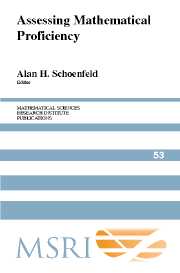Book contents
- Frontmatter
- Contents
- Preface
- Acknowledgments
- Section 1 The Big Picture
- Section 2 Perspectives on Mathematical Proficiency
- Section 3 What Does Assessment Assess? Issues and Examples
- Section 4 The Case of Algebra
- 11 Assessing the Strands of Student Proficiency in Elementary Algebra
- 12 Making Meaning in Algebra: Examining Students' Understandings and Misconceptions
- 13 Task Context and Assessment
- Section 5 What Do Assessments Assess? The Case of Fractions
- Section 6 The Importance of Societal Context
- Epilogue: What Do We Need to Know? Items for a Research Agenda
- About the Authors
- Subject Index
- Author Index
- Task Index
11 - Assessing the Strands of Student Proficiency in Elementary Algebra
Published online by Cambridge University Press: 06 July 2010
- Frontmatter
- Contents
- Preface
- Acknowledgments
- Section 1 The Big Picture
- Section 2 Perspectives on Mathematical Proficiency
- Section 3 What Does Assessment Assess? Issues and Examples
- Section 4 The Case of Algebra
- 11 Assessing the Strands of Student Proficiency in Elementary Algebra
- 12 Making Meaning in Algebra: Examining Students' Understandings and Misconceptions
- 13 Task Context and Assessment
- Section 5 What Do Assessments Assess? The Case of Fractions
- Section 6 The Importance of Societal Context
- Epilogue: What Do We Need to Know? Items for a Research Agenda
- About the Authors
- Subject Index
- Author Index
- Task Index
Summary
Algebra and Functions
In order to assess something, you have to have some idea of what that something is. Algebra means many different things in today's schools (for a discussion, see [RAND 2003, Chapter 4]). In particular, the study of algebra is often blended with the study of functions. Although it is true that the notion of a function is lurking behind much of beginning algebra, and that there is an algebraic aspect to many of the tasks we want our students to carry out with functions, the conglomeration of algebra and functions has considerably muddied the waters in the teaching of algebra. Therefore, I'd like to spend some time clarifying my own stance before talking about how to assess proficiency. In the process, while acknowledging other possible uses, I will use the word “algebra” to mean the study of algebraic expressions and equations in which the letters stand for numbers. I include in this study consideration of the relationship between the algebraic form of expressions and equations and properties of their values and solutions. I make a distinction, however, between this study and the study of functions.
In the progression of ideas from arithmetic to algebra to functions, there is an increase in abstraction at each step, and the increase at the second step is at least as large as that at the first. In the step from arithmetic to algebra, we learn to represent numbers by letters, and calculations with numbers by algebraic expressions.
- Type
- Chapter
- Information
- Assessing Mathematical Proficiency , pp. 157 - 162Publisher: Cambridge University PressPrint publication year: 2007
- 1
- Cited by



